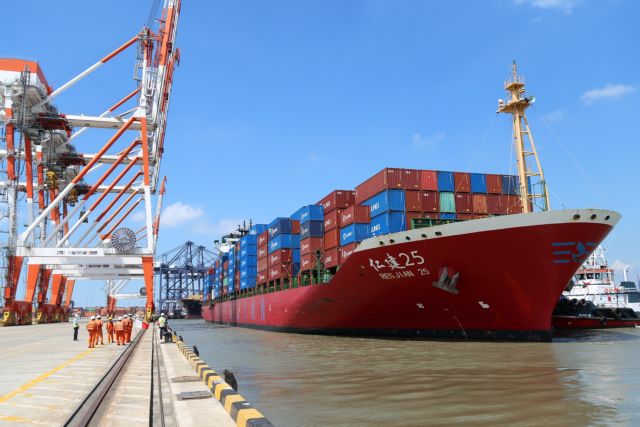 Society
Society

 |
| A shipping vessel docked at Cái Mép- Thị Vải deep-water port in Bà Rịa-Vũng Tàu Province. — VNA/VNS Photo Huỳnh Ngọc Sơn |
HCM CITY — The Ministry of Transport has approved a VNĐ1.4 trillion (US$59.6 million) project to upgrade the capacity of the navigation channel leading ships into the Cái Mép – Thị Vải port cluster in Bà Rịa-Vũng Tàu province, a move that will allow passage of mega vessels (over 18,000 TEU).
The port cluster in Phú Mỹ Township is an important international transit port, contributing greatly to the country’s socio-economic development.
However, the navigational channel leading ships into the port cluster now only has a water depth of 14m which prevents massive ships from docking at the ports.
As a result, when a large vessel arrives at the ports, the number of containers can only reach 45-50 per cent of the vessel’s maximum capacity.
The project aims to enhance the port cluster’s operational efficiency by developing international gateway ports in the southern province to boost trade in the region.
The upgrading of the navigation channel will start from buoy No.0 to the upstream of the Cái Mép International Terminal (CMIT) to facilitate the access of ships of 160,000 deadweight tonnage (DWT) with a full load, 120,000 DWT vessels for two-way operation and ships 200,000 DWT/18,000 TEU (1 TEU = 20-foot container) offloaded or larger for one-way operation.
The section from the upstream of CMIT to the upstream of Tân Cảng Cái Mép International Terminal (TCIT) and Tân Cảng Cái Mép Container Terminal (TCCT) facilitates the access of ships of 120,000 DWT with full cargo, vessels of 100,000 DWT operating two-way and ships of 160,000 DWT offloaded or larger ones for one-way operation.
And the section from the upstream of TCIT and TCCT to the Phước An Port facilitates ships of 60,000 DWT full load or larger for one-way operation.
The project’s investment capital will be allocated from the State budget in the medium-term public investment plan for the period of 2021-25.
The capital will be allocated in accordance with the project’s four-phase execution schedule, starting from 2022.
The project is scheduled to start in the fourth quarter of this year.
Once completed, it is expected to encourage investment in the region and strengthen local socio-economic development, while also increasing revenue to the State budget to pay the yearly maintenance and dredging expenses.
According to Tân Cảng Sài Gòn Corporation, the Cái Mép - Thị Vải port cluster is also investing in upgrading infrastructure to increase cargo-loading capacity.
The port cluster had reached over 90 per cent of its designed capacity.
By 2023, the port cluster’s capacity is expected to increase by 53 per cent compared to 2020.
In the last five years, the volume of goods passing through the port cluster grew at an average of 20.3 per cent per year.
In the first six months of the year, the total volume of goods passing through the port cluster reached more than 54.4 million tonnes, a year-on-year increase of 16 per cent.
Of that total, the volume of container cargo was estimated at more than 4.5 million twenty-foot equivalent units (TEUs), up 41 per cent over the same period last year.
In January, Gemalink International Port’s first phase opened at Cái Mép-Thị Vải port cluster, with an annual capacity of 1.5 million TEUs, raising the port cluster’s annual capacity to 8.3 million TEUs.
Last year the port cluster handled cargo amounting to 7.75 million TEUs, equivalent to 91 per cent of its designed capacity, according to the Việt Nam Maritime Administration.
Only eight transport routes were linked to the Cái Mép - Thị Vải port cluster in 2013.
There are now 32 transport routes connecting to the ports, including 25 international routes and seven domestic routes.
The volume of goods is expected to increase in the coming time because of growth in trade and cargo volume in service routes connecting Cái Mép - Thị Vải port cluster and other continents such as Europe and America, and Intra Asia Pacific shipping routes.
Construction work is being sped up on several transport projects to improve connections between the port cluster and other localities in the region, such as the Biên Hoà-Vũng Tàu and Bến Lức - Long Thành expressways, Phước Hòa - Vũng Tàu Route, and an inter-port road.
The Cái Mép - Thị Vải port cluster began operating in 2009. It is expected to be developed into an export and import gateway for the southern key economic region and a world-class seaport hub by 2045. — VNS




